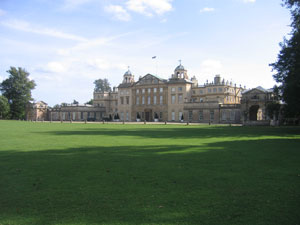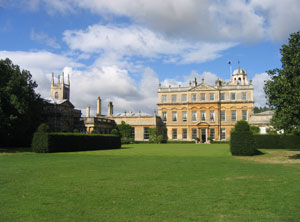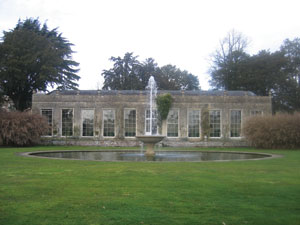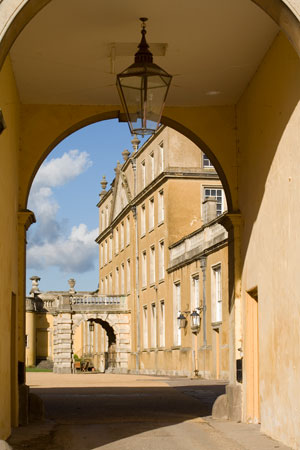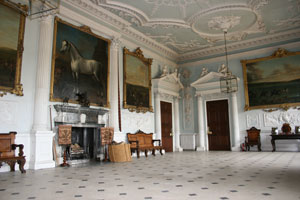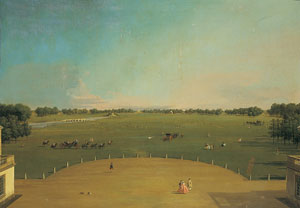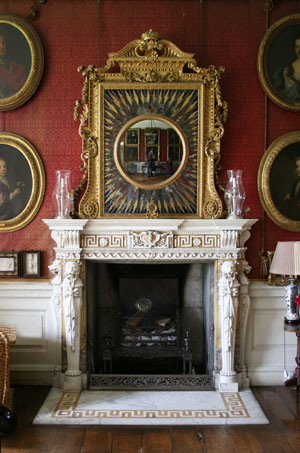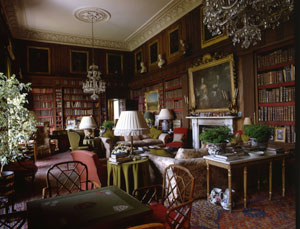ARCHITECTURAL DIGEST: Summer 1987
by Anne Somerset
Queen Anne visited Badminton in 1702
BADMINTON HOUSE, GLOUCESTERSHIRE
In February 1984 my father inherited Badminton House on the death of our cousin, the tenth Duke of Beaufort, and I was appalled to learn that we would be moving in as soon as possible. Thanks to the generosity of the late Duke, for twenty-one years we had lived in a delightful house in the village, and I had assumed that this arrangement would continue even after Badminton became my father’s responsibility. Because of financial pressures, many other owners of stately homes had either withdrawn into conveniently sized flats situated in wings of their houses or had moved out altogether, and I did not think my father would think it feasible to defy this trend.
In this, however, I was mistaken, for when the time came he decided that it would be both defeatist and misguided if we remained where we were. Badminton House would have to be maintained and repaired even if we did not live there, and though it could have been opened to the public and turned into a museum, it was unlikely that it would attract enough visitors to pay for its upkeep. On the other hand, if we made it our home, we would not have to spread ourselves through its entirety, for most of the finest rooms in the house are on is eastern side. If we occupied these and used the bedrooms immediately above them, we would be living in a relatively compact and manageable unit only marginally larger than our former house in the village. Some modernisation would of course be necessary - the kitchen, for example, was originally situated well over a hundred yards from the dining room and would have to be moved - but the alterations could be kept to a minimum and could be executed without great difficulty. Unlikely though it seemed, my father concluded that the best way to preserve the house would be to keep it as a family home.
I had not realized that my father had been cogitating in this way, and the announcement of our impending change of residence therefore came as a considerable shock. It was not that the house held painful memories; quite the contrary, in fact, for until I was eight years old my brothers and I had spent all our school holidays at Badminton and had found the house and its environs to be something of a children’s paradise. The grand rooms on the east front nevertheless had few happy associations, because unless there were guests in the house the rooms were kept shuttered and locked, and on the whole the old Duke and his wife found it more convenient to sit in a smaller room adjoining the hall. Mindful of our destructive propensities, they decreed that the state rooms were out of bounds to us children on all except special occasions, and this was one rule we did not feel tempted to break. The rooms were freezing cold in winter, deserted and eerie even in summer and, unlike most forbidden territory, seemed utterly uninviting.
Since that time the atmosphere on this side of the house has been transformed, and I find it hard to imagine how I could have ever thought it cheerless. Superficially, however, the rooms have changed remarkably little, and it is regular use rather than redecoration that is responsible for the metamorphosis. Most of the draperies and wallpapers are antique, but quite apart from the cost of replacing them, my parents felt strongly that part of the charm of the house lay in the fact that it had not been constantly altered to suit the inclinations of its successive owners.
The history of the house can be summed up very briefly. The estate was purchased in 1608, but the Somerset family only made Badminton their principal residence after their Welsh stronghold, Raglan Castle, was destroyed during the English Civil Wars. Soon after the restoration of Charles II, the Marquis of Worcester (the head of the family, who was subsequently made first Duke of Beaufort) commissioned an unknown architect to remodel and enlarge the comparatively modest manor house that had originally stood on the site. The process was completed nearly eighty years later when the third Duke topped the house with its distinctive Baroque cupolas and added two Palladian wings flanked by square pavilions. At about the same time, the North Hall was redesigned and adorned with elaborate plasterwork, though whether this was by James Gibbs - who was responsible for the wings and their pavilions - or William Kent, the experts cannot now decide. Subsequent generations naturally effected further changes in the interior, the most notable being the early-nineteenth-century redecoration by Wyatville of the library and large drawing room, but on the whole the Somersets seem o have taken the view that their habitat required little embellishment. They clung to the familiar with a stubbornness worthy of their somewhat complacent family motto: “I scorn to fear or change”.
It would probably be wrong to imply that their reluctance to tamper with their surroundings arose solely from their aesthetic appreciation of old things, for the family passion was fox-hunting, and one has the impression that most of the dukes and duchesses were so absorbed in the chase that they had little time to devote to patronizing the arts. Of course there were exceptions: in the early eighteenth century one member of the family was perceptive enough to realize that John Wootton, whose father worked at Badminton as a servant, was a talented artist, and sent him to Rome for training. This benevolence was rewarded when Wootton returned and painted several large canvases of his patron engaged in various sporting pursuits. The third Duke was also clearly a cultured man, who travelled to Rome to have his portrait painted by Trevisani and attempted to build a fine collection of Italian paintings and furniture, but in this he was untypical of his family. Sport was their obsession, and I suspect that if one could summon back previous occupants of the house and ask them for a guided tour, many of them would attach more importance to the fact that the game of badminton was played in the hall than to the paintings that hang there.
Such priorities account for the fact that the interior of the house has remained in a state of virtual fossilisation. And while not everyone would agreed that this is a good thing - the Dowager Duchess told my mother that when she proudly informed a party of visitors that the wallpaper in our dining room was nearly one hundred and seventy years old, she heard one of them murmur, “You’d have thought they’d be sick of it by now” - we think ourselves very fortunate to have had forebears who were a somewhat unimaginative lots. When my father inherited the house, he and my mother agreed that where change was desirable it should be done by adapting what was there rather than by beginning afresh.
Thus, in the library, which we use as our principal sitting room, a sombre wooden panel above the fireplace has been replaced by a Lely double portrait in an elaborate frame. My parents also experimented by hanging the two Canalettos of the house - which had previously rested on easels in the rarely used drawing room - over bookshelves in the library and found that they fitted perfectly. In the smaller yellow sitting room there have been similar slight modifications, for previously this was little more than a very grand passage that led to the drawing room, with chairs ranged stiffly around the walls, interspersed with cabinets containing meticulously arranged displays of china. It was not a room in which one felt inclined to linger (unless, perhaps, one’s attention was caught by a glass case containing such supposed objects of interest as a solitary glass eye), but it came to life as soon as the furniture was grouped more informally, and the walls were crowded with pictures scavenged from every corner of the house. The glass eye has also been banished and no longer fixes us with its unwinking gaze.
These rearrangements can scarcely be described as radical, but the results at Badminton have certainly been dramatic. It is a constant source of surprise to me that rooms which in their fundamentals have remained unchanged since my childhood should nonetheless seem so very different to me now.
by Anne Somerset
Queen Anne visited Badminton in 1702
BADMINTON HOUSE, GLOUCESTERSHIRE
In February 1984 my father inherited Badminton House on the death of our cousin, the tenth Duke of Beaufort, and I was appalled to learn that we would be moving in as soon as possible. Thanks to the generosity of the late Duke, for twenty-one years we had lived in a delightful house in the village, and I had assumed that this arrangement would continue even after Badminton became my father’s responsibility. Because of financial pressures, many other owners of stately homes had either withdrawn into conveniently sized flats situated in wings of their houses or had moved out altogether, and I did not think my father would think it feasible to defy this trend.
In this, however, I was mistaken, for when the time came he decided that it would be both defeatist and misguided if we remained where we were. Badminton House would have to be maintained and repaired even if we did not live there, and though it could have been opened to the public and turned into a museum, it was unlikely that it would attract enough visitors to pay for its upkeep. On the other hand, if we made it our home, we would not have to spread ourselves through its entirety, for most of the finest rooms in the house are on is eastern side. If we occupied these and used the bedrooms immediately above them, we would be living in a relatively compact and manageable unit only marginally larger than our former house in the village. Some modernisation would of course be necessary - the kitchen, for example, was originally situated well over a hundred yards from the dining room and would have to be moved - but the alterations could be kept to a minimum and could be executed without great difficulty. Unlikely though it seemed, my father concluded that the best way to preserve the house would be to keep it as a family home.
I had not realized that my father had been cogitating in this way, and the announcement of our impending change of residence therefore came as a considerable shock. It was not that the house held painful memories; quite the contrary, in fact, for until I was eight years old my brothers and I had spent all our school holidays at Badminton and had found the house and its environs to be something of a children’s paradise. The grand rooms on the east front nevertheless had few happy associations, because unless there were guests in the house the rooms were kept shuttered and locked, and on the whole the old Duke and his wife found it more convenient to sit in a smaller room adjoining the hall. Mindful of our destructive propensities, they decreed that the state rooms were out of bounds to us children on all except special occasions, and this was one rule we did not feel tempted to break. The rooms were freezing cold in winter, deserted and eerie even in summer and, unlike most forbidden territory, seemed utterly uninviting.
Since that time the atmosphere on this side of the house has been transformed, and I find it hard to imagine how I could have ever thought it cheerless. Superficially, however, the rooms have changed remarkably little, and it is regular use rather than redecoration that is responsible for the metamorphosis. Most of the draperies and wallpapers are antique, but quite apart from the cost of replacing them, my parents felt strongly that part of the charm of the house lay in the fact that it had not been constantly altered to suit the inclinations of its successive owners.
The history of the house can be summed up very briefly. The estate was purchased in 1608, but the Somerset family only made Badminton their principal residence after their Welsh stronghold, Raglan Castle, was destroyed during the English Civil Wars. Soon after the restoration of Charles II, the Marquis of Worcester (the head of the family, who was subsequently made first Duke of Beaufort) commissioned an unknown architect to remodel and enlarge the comparatively modest manor house that had originally stood on the site. The process was completed nearly eighty years later when the third Duke topped the house with its distinctive Baroque cupolas and added two Palladian wings flanked by square pavilions. At about the same time, the North Hall was redesigned and adorned with elaborate plasterwork, though whether this was by James Gibbs - who was responsible for the wings and their pavilions - or William Kent, the experts cannot now decide. Subsequent generations naturally effected further changes in the interior, the most notable being the early-nineteenth-century redecoration by Wyatville of the library and large drawing room, but on the whole the Somersets seem o have taken the view that their habitat required little embellishment. They clung to the familiar with a stubbornness worthy of their somewhat complacent family motto: “I scorn to fear or change”.
It would probably be wrong to imply that their reluctance to tamper with their surroundings arose solely from their aesthetic appreciation of old things, for the family passion was fox-hunting, and one has the impression that most of the dukes and duchesses were so absorbed in the chase that they had little time to devote to patronizing the arts. Of course there were exceptions: in the early eighteenth century one member of the family was perceptive enough to realize that John Wootton, whose father worked at Badminton as a servant, was a talented artist, and sent him to Rome for training. This benevolence was rewarded when Wootton returned and painted several large canvases of his patron engaged in various sporting pursuits. The third Duke was also clearly a cultured man, who travelled to Rome to have his portrait painted by Trevisani and attempted to build a fine collection of Italian paintings and furniture, but in this he was untypical of his family. Sport was their obsession, and I suspect that if one could summon back previous occupants of the house and ask them for a guided tour, many of them would attach more importance to the fact that the game of badminton was played in the hall than to the paintings that hang there.
Such priorities account for the fact that the interior of the house has remained in a state of virtual fossilisation. And while not everyone would agreed that this is a good thing - the Dowager Duchess told my mother that when she proudly informed a party of visitors that the wallpaper in our dining room was nearly one hundred and seventy years old, she heard one of them murmur, “You’d have thought they’d be sick of it by now” - we think ourselves very fortunate to have had forebears who were a somewhat unimaginative lots. When my father inherited the house, he and my mother agreed that where change was desirable it should be done by adapting what was there rather than by beginning afresh.
Thus, in the library, which we use as our principal sitting room, a sombre wooden panel above the fireplace has been replaced by a Lely double portrait in an elaborate frame. My parents also experimented by hanging the two Canalettos of the house - which had previously rested on easels in the rarely used drawing room - over bookshelves in the library and found that they fitted perfectly. In the smaller yellow sitting room there have been similar slight modifications, for previously this was little more than a very grand passage that led to the drawing room, with chairs ranged stiffly around the walls, interspersed with cabinets containing meticulously arranged displays of china. It was not a room in which one felt inclined to linger (unless, perhaps, one’s attention was caught by a glass case containing such supposed objects of interest as a solitary glass eye), but it came to life as soon as the furniture was grouped more informally, and the walls were crowded with pictures scavenged from every corner of the house. The glass eye has also been banished and no longer fixes us with its unwinking gaze.
These rearrangements can scarcely be described as radical, but the results at Badminton have certainly been dramatic. It is a constant source of surprise to me that rooms which in their fundamentals have remained unchanged since my childhood should nonetheless seem so very different to me now.
